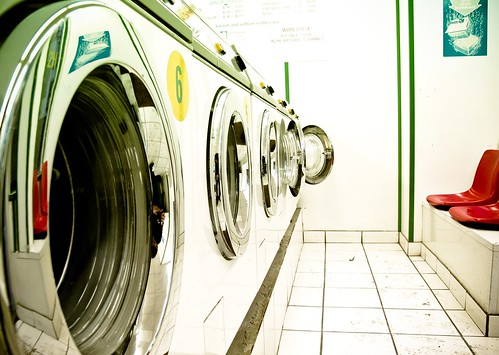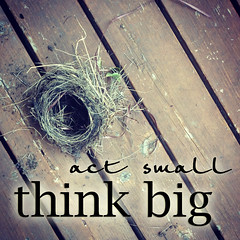guest post by Jennifer Robbins
If
you're like me, you love fabric softener and dryer sheets. They keep
your sheets soft, your shirts smelling lovely, and your skirts
static free. Unfortunately they can contain just as many toxic
chemicals as conventional laundry detergent, which we now know is a
lot!
In
fact, fabric softener may quite possibly be the most toxic
product in your home. It is essentially a toxic cocktail you pour
in your laundry. Worse still, many of these fabric
softeners are actually designed to penetrate the fibers of your
clothes and slowly release over time. So they are
slowly releasing their toxic sludge right on your skin. Here are
a few of the chemicals that are found in your pastel-colored fabric
softener:
- Chloroform, a carcinogenic neurotoxin
- Camphor, causes central nervous disorders and is easily absorbed through skin
- Alpha Terpineol, can cause central nervous damage as well as respiratory problems
- Ethanol, considered a hazardous waste by the EPA and can cause central nervous system disorders
Do
any of those sound like something you want in constant contact with
your skin? I didn't think so.
Now,
let's talk about dryer sheets. They are basically thin sheets of
polyester coated in toxic chemicals designed to make your clothes
smell "fresh and clean". And what happens to those
toxic chemicals when they are heated up in the dryer? They are
released through the dryer vent, adding awful VOCs (volatile organic
compounds) to our already polluted air. Many of the chemicals I just
listed in the fabric softener section are also found in your dryer
sheets, as well as Pentane (can cause headaches, nausea,
vomiting, dizziness, etc) and Ethyl Acetate (a narcotic
considered a hazardous waste by the EPA that may
cause headaches and narcosis). None of that sounds like a good idea
to me!
Now
that you know why you should say farewell to these products, let's
talk about your options. The first is simply eliminating them
entirely. They aren't essential to doing laundry as laundry detergent
is, so you can cut them out. But what if you loves fresh
scented soft laundry and don't want to give it up? You have a few
options, actually.
For
fabric softener:
- Vinegar - Really, all you need is a 1/4 cup of vinegar where you usually added fabric softener and you're good to go. Your clothes won't smell like vinegar after the wash, but if you miss the scented aspect of fabric softener just add a dozen drops of essential oil to the vinegar bottle and shake well before each use.
- Vinegar/Baking Soda - this recipe is a tad more complicated but will look and work just like conventional fabric softener without all the chemicals. Mix 1 gallon of vinegar, 2 cups of baking soda, and 2-3 cups of hair conditioner. Store in an airtight container for up to 3 months and use 1/4 to 1/2 cup per load as needed.
- Green Shield Organic Fabric Softener, Lavender Mint - This is the only fabric softener to receive an A rating from the Environmental Working Group (EWG). It's made of natural ingredients instead of chemicals and is virtually the only nontoxic store bought option for fabric softener.
For
dryer sheets:
- Wool Dryer Balls - You can make these (there are lots of tutorials online) or buy them. Wool dryer balls contain zero harmful chemicals and last for thousands of loads, making them green and wallet friendly! They control the static and keep laundry as soft as a dryer sheet. By nature they are scent-free, but just add a couple drops of your favorite essential oil (I use lavender) before you toss them in the dryer and you have a scented environmentally-friendly dryer sheet alternative
- Cotton or Wool Dryer Sheet - If you just miss the fragrance of the dryer sheet, cut up an old t-shirt into a square and add 2-4 drops of essential oil to it. Let the oil dry thoroughly, then use just like you would a dryer sheet. Except instead of throwing it away after one use, you can use it over and over again! Simply add more oil when the smell fades away.
- Plastic Dryer Balls - You can buy these at most store these days. They function similarly to the wool dryer balls, but are not known to last as long. They are a great alternative for those allergic to wool.
You
may have noticed I didn't give a store bought dryer sheet in that
list. That's because not a single dryer sheet on the market
received any higher than a D rating by the EWG. That means that
literally every product on the market (even those "all-natural"
ones) could potentially be hazardous. The good news about that is
that any of the 3 options we listed above will save you money and
help the environment. Because dryer sheets are single-use items, they
are incredibly wasteful. All three of those options will last you
multiple loads, which means you won't be spending $6 every 130 loads
of laundry like you used to!
I
know change can be uncomfortable, but you don’t have to jump all in
and change everything at once. Start with eliminating fabric softener
and see how you feel. Then maybe give wool dryer balls a shot. Make
the conversion to safe and green laundry care complete by using
toxic-free detergent. You may find that not only do you feel better
by helping the environment, your family may actually feel better
physically! So give it a shot. You never know how important this
small change might be.
Interested in more green laundry tips? Check out Jennifer's companion post here on Act Small Think Big, Toxic Laundry: Skip the Fabric Softener.
* * *
Jennifer is a blogger, professional writer, and reluctant accountant.
She loves DIY projects, Dr. Pepper, and searching for treasures in
thrift stores. She's kinda crunchy but definitely opinionated. Jennifer
resides in small town Oklahoma with her new husband, puppy, and kitty. You can visit her online at Mrs. Robbins Sparkles.
Photo credit: sinkdd via Creative Commons










